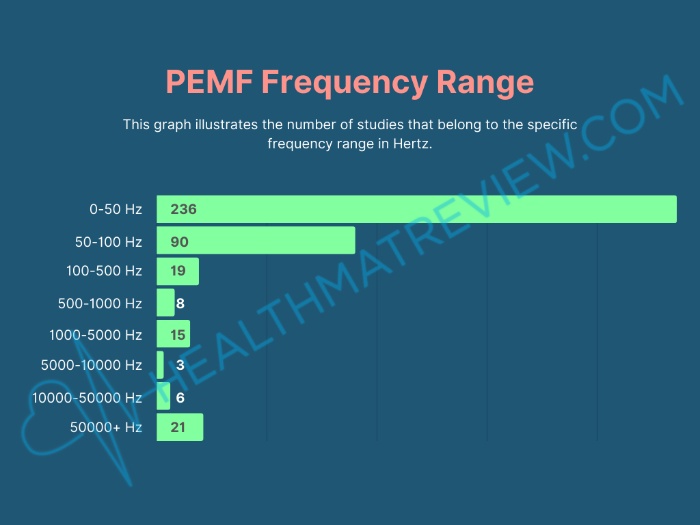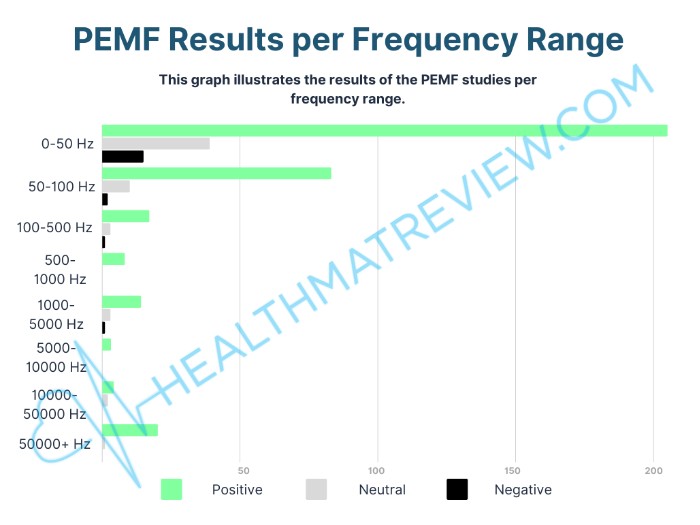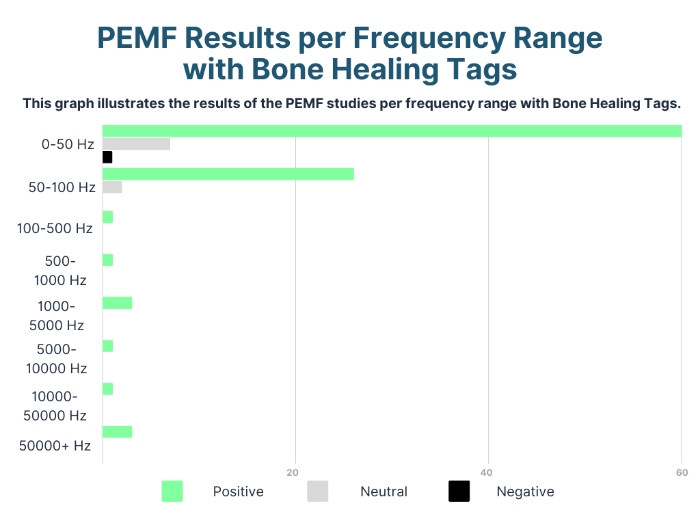PEMF Frequency Charts from our 335 PEMF Study Database
Skip the hearsay and start with the charts to see where positive result findings from clinical PEMF research actually clusters by frequency range band from our 335 PEMF study database.
Use the links to visit the database pages and view the studies which fall into each range band, from the whole database, only pain relief studies or only bone healing studies – or search the database for any study category.
Entire Database: Frequency Ranges Chart
This chart shows the number of research studies which tested PEMF settings in each given PEMF frequency range from the full 335 study database.

It’s easy to see that the vast majority of studies tested in the 0 to 50 Hz frequency category.
Point of note is that the numbers on the above chart add up to more than 335 studies, and that’s because some studies tested multiple frequencies and those are included in the bars.
This chart is one of a few used to give us a better picture of what the PEMF in our database looks like which we look at on our What is PEMF therapy page.
Entire Database: Results by Frequency Range Chart
This chart represents how many results (positive, neutral or negative) were found in each given range band in the full database.

It’s easy to see that the heaviest weighting of positive results is in the 0 to 50Hz category.
Any of these buttons below will take you to our full database page for just studies falling into these frequency ranges:
Frequency Range Database Links
Bone Healing Studies Only: Results by Frequency Range Chart
This chart is the same as above, how many results (positive, neutral or negative) were found in each given range band only limiting to only PEMF for bone healing studies.

The majority of studies for bone healing were in the 0 to 75Hz range, falling into the 0-50Hz and 50-100Hz baskets.
You’ll find this chart also on our PEMF for Bone Healing Macro Analysis page where we go into further detail on the studies which are in this chart, provide a PEMF for bone healing searchable database as well as look at the mechanisms of how PEMF actually works for healing bone.
Any of the following buttons will take you to the PEMF for bone specific database section with that specific filter range applied:
Frequency Range Database Links
Pain Relief Studies Only: Results by Frequency Range Chart
A topic of great interest, PEMF for pain relief, this chart is again the same as above, depicting how many results (positive, neutral or negative) were found in each frequency range band but this time only for pain relief studies.

In this case, the vast majority of the studies were in the 0 to 50 Hz category.
You’ll find this chart also on our PEMF for Pain Macro Analysis page where we go into further detail on the studies which are in this chart, provide a PEMF for pain searchable database as well as look at the mechanisms of how PEMF actually works for pain.
Any of the following button links will take you to the PEMF for pain specific database filtered to the particular frequency range:
Frequency Range Database Links
Practical Guidance – Picking PEMF Frequencies
From my own experience, PEMF frequency can move brain activity toward different operating patterns—so it’s reasonable to use familiar EEG “brainwave” ranges as a guide (e.g., try higher frequencies in the morning, lower ones before bed).
While this isn’t researched in clinical PEMF studies, you can probably ask anyone you know with a PEMF mat if using low, low frequencies before bed helps them get sleepy or high frequencies in the morning helps wake them up.
My own experience was using 30Hz, what we would think to be a reasonably low PEMF frequency, and finding my mind racing like mad, intensely focused – while putting me in a productive state it wasn’t particularly comfortable.
These brain ranges are well-established in clinical EEG; for definitions see StatPearls’ open-access overview and they’re an excellent starting point for choosing what PEMF frequency to use (in my own opinion).
- 0.5–4 Hz — Delta: deep, restorative sleep; highest arousal threshold.
- 4–8 Hz — Theta: drowsy/light sleep, relaxed/meditative, internal focus.
- 8–12 Hz — Alpha: relaxed wakeful, eyes-closed posterior rhythm; fades with eyes open/mental effort.
- 11–16 Hz — Sigma (sleep spindles): brief sleep bursts tied to memory consolidation.
- 13–20 Hz — Low Beta: alert focus, sustained attention, motor readiness.
- 20–35 Hz — High Beta: effortful cognition/problem-solving; may rise with muscular tension.
- ~30–55/60 Hz — Low Gamma: fast sensory binding/feature integration.
- ~60–120/150 Hz — High Gamma: fine-scale/local processing
I say this because, firstly what we did notice from our analysis of the 335 studies, is that almost every frequency, intensity and waveform found some kind of benefit – and if this is the case then why not choose our frequency settings based on natural rhythms of the human body.
Please note that the EEG brain frequencies list is context, as is my opinion and not medical advice, (see our disclaimer), and naturally other factors matter here, intensity, waveform, where the PEMF is applied (eg. full body, elbow, etc.); however in my opinion these guidelines are an excellent place to begin and you could take my experience at 30Hz as a point of reference on how you may experience PEMF frequencies yourself.
Methods & Sources
Charts on this page come from our curated dataset of 335 PEMF studies.
We binned reported frequencies into predefined ranges, de-duplicated overlapping reports, and labeled outcomes as “positive” when authors concluded benefit for the stated endpoint.
For more information on the methods and studies of the database visit our About the PEMF studies page, and for further reading I highly recommend you check out our PEMF Signal Analysis page where we try and determine with a macro analysis of the research if we can find what the optimal PEMF settings are.
FAQ
Bioelectric signaling in tissues is slow and many approved clinical PEMF signals were validated in the 0–100 Hz window; research has simply concentrated there.
Not reliably—EEG bands are context, not prescriptions; outcomes depend on intensity, waveform, duty cycle, exposure time, and target tissue however it is an excellent starting point which this author can say from my own adverse PEMF experience.
Sometimes—bone healing often uses ~15–75 Hz clinically, while pain studies span mainly concentrate below 50Hz; frequency is only one part of “dose”, but it’s important to consider that positive outcomes were found across the frequency, intensity and waveforms board so to speak. In other words there may not be one best frequency for any given condition.
Magnetic flux density (mT/Gauss) also known as intensity, waveform, burst structure/duty cycle, treatment duration, and session frequency; one thing not often mentioned, variation – if there isn’t a true most effective frequency experiencing a number of them is a safer bet.
No consensus master chart exists; the most honest approach (I think) is evidence-by-indication with links to the underlying studies which is what we try to provide here.




Comments are moderated. Tick “Email me when my question is replied to” to get notified.